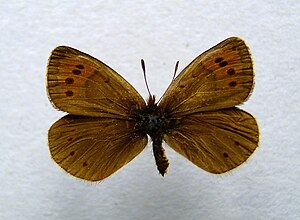Gray-brown Mohrenfalter
| Gray-brown Mohrenfalter | ||||||||||||
|---|---|---|---|---|---|---|---|---|---|---|---|---|

Gray-brown Mohrenfalter ( Erebia pandrose ) |
||||||||||||
| Systematics | ||||||||||||
|
||||||||||||
| Scientific name | ||||||||||||
| Erebia pandrose | ||||||||||||
| ( Borkhausen , 1788) |
The Graubraune Mohrenfalter ( Erebia pandrose ) is a butterfly (day butterfly ) from the noble butterfly family (Nymphalidae).
features
butterfly
The forewings of the moths, which have a wingspan of about 30 to 38 millimeters, are dark brown in color and show a reddish brown band in the post-disk region . This is slightly segmented by lighter colored veins and usually shows four eye spots. On the inside the band is delimited by a clear disc line. The hind wing underside is pale silver gray to dark gray in color. Due to the peculiar flight behavior, the moths are easily recognizable, as they hold the forewings upright almost motionlessly when flying, whereby the flapping hind wings responsible for locomotion with the gray hues of the underside play a visually dominant role and a striking, hopping line of movement arises. This strange flight image also shows the mirror-spotted thick-headed butterfly ( Heteropterus morpheus ).
Caterpillar, pupa
The caterpillars are colored green, equipped with fine bristles, have a black back line, side stripes made of black lines and red-brown anal tips. The doll has a greenish base color and shows two black lines on the head and a dirty yellow-brown abdomen.
Similar species
In the similar species Erebia sthennyo , the eye-spots are closer to the edge of the wing and the disc line is often missing. In addition, the species is only found in some areas of the Pyrenees that do not overlap with pandrose .
Synonyms
- Erebia lappona
distribution and habitat
The main distribution area of the brown moth stretches from arctic areas of Northern Europe, the Pyrenees, the Alps , the Apennines , the Carpathians, the Kola and Kanin peninsulas , parts of the Urals as well as the Altai and Sajan Mountains to Mongolia . The species is preferably found on short grassy mountain meadows. In the Alps it can be found between 1600 and 3000 meters.
Way of life
The moths fly in one generation from June to August. The development cycle lasts two years. The caterpillars feed primarily on fescue species ( Festuca ) as well as panicle grasses ( Poa ) and blue grasses ( Sesleria ).
Danger
In Germany, the species occurs only in a few places in the Bavarian Alps and is listed on the Red List of Endangered Species in Category R (species with geographical restriction). But it can appear in large numbers in very local places.
swell
Individual evidence
- ^ A b Walter Forster, Theodor A. Wohlfahrt: The butterflies of Central Europe. Volume 2: Butterflies. (Rhopalocera and Hesperiidae). Franckh'sche Verlagshandlung, Stuttgart 1955, DNB 456642188 .
- ↑ a b c Tom Tolman, Richard Lewington: The butterflies of Europe and Northwest Africa . Franckh-Kosmos, Stuttgart 1998, ISBN 3-440-07573-7 .
- ↑ Federal Agency for Nature Conservation (Ed.): Red List of Endangered Animals in Germany . Landwirtschaftsverlag, Münster 1998, ISBN 3-89624-110-9 .
literature
- Tom Tolman, Richard Lewington: The butterflies of Europe and Northwest Africa . Franckh-Kosmos, Stuttgart 1998, ISBN 3-440-07573-7 .
- Walter Forster , Theodor A. Wohlfahrt : The butterflies of Central Europe. Volume 2: Butterflies. (Rhopalocera and Hesperiidae). Franckh'sche Verlagshandlung, Stuttgart 1955, DNB 456642188 .
Web links
- Lepiforum e. V. Taxonomy and Photos
- www.nic.funet.fi dissemination
- www.schmetterlinge-deutschlands.de Endangerment
- Erebia pandrose at Fauna Europaea
